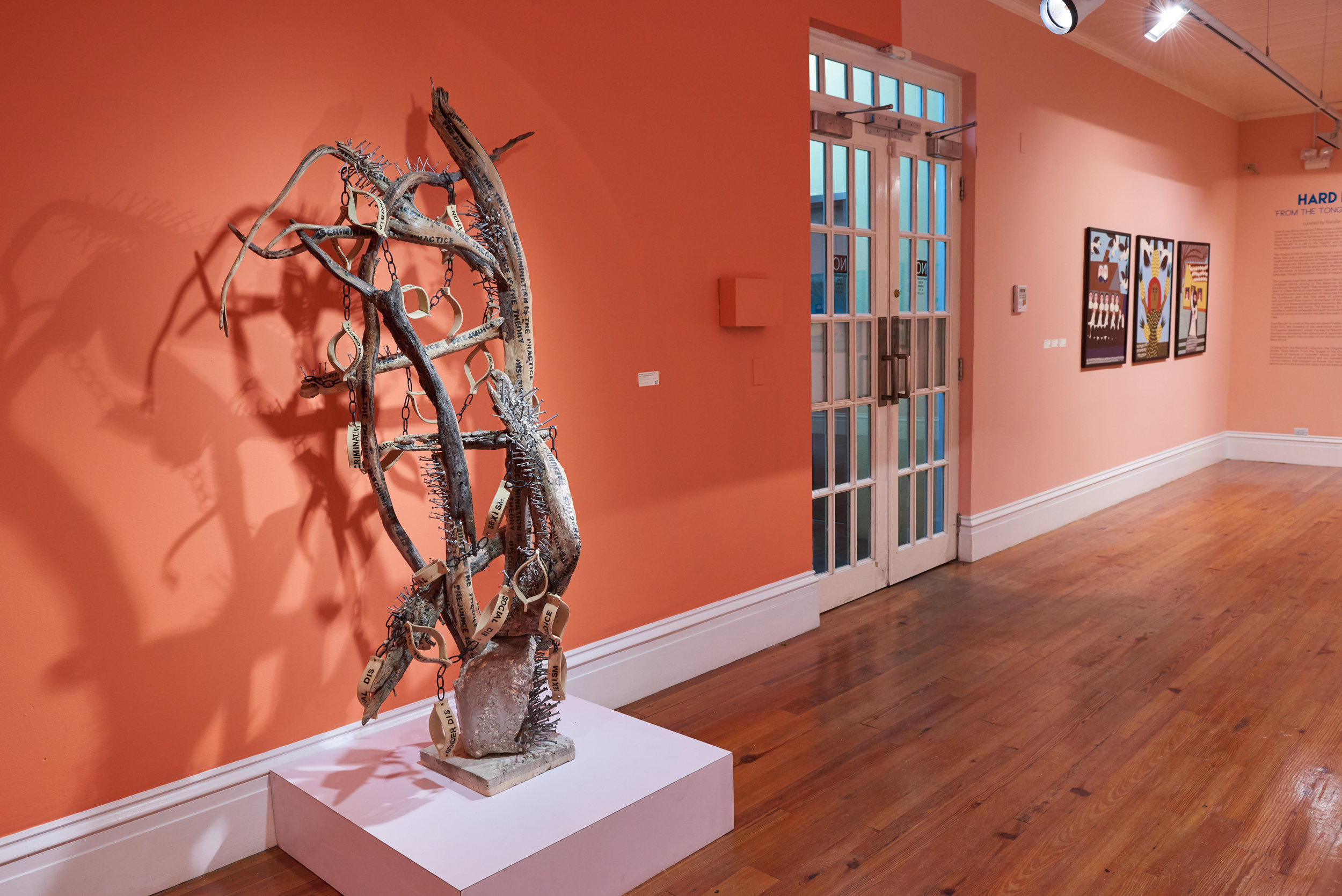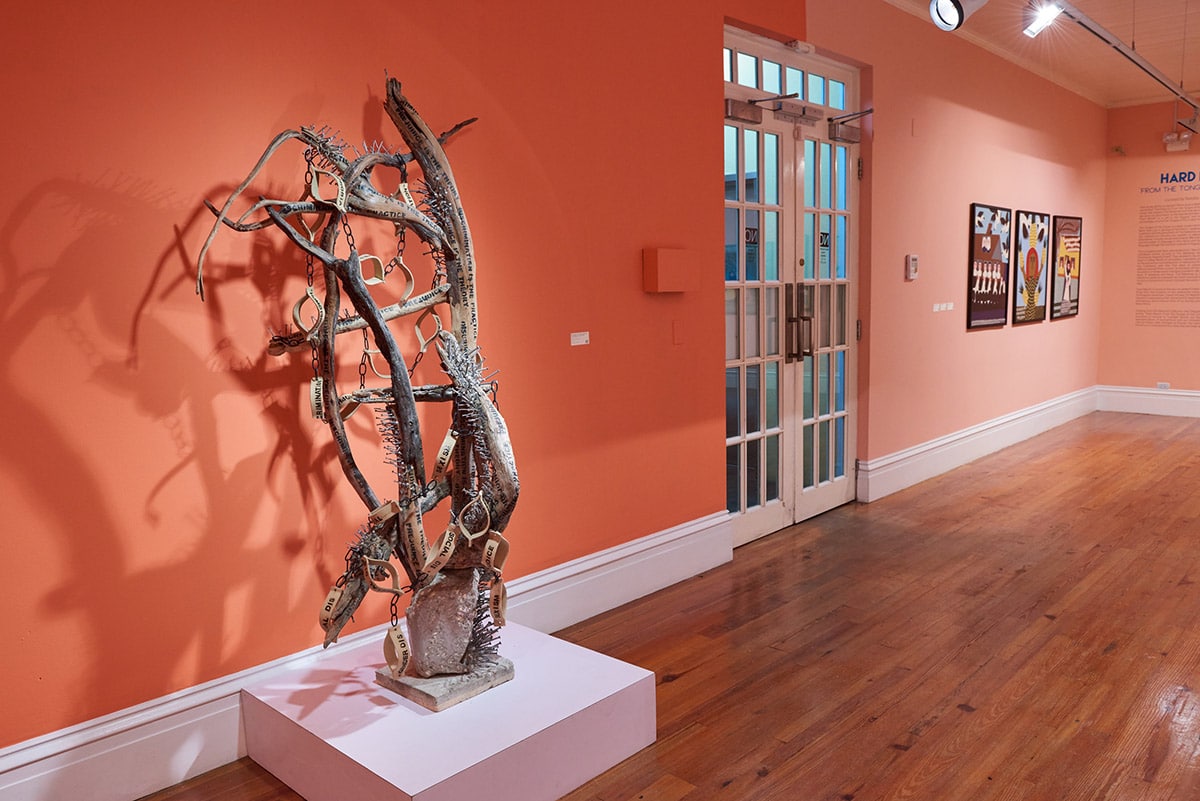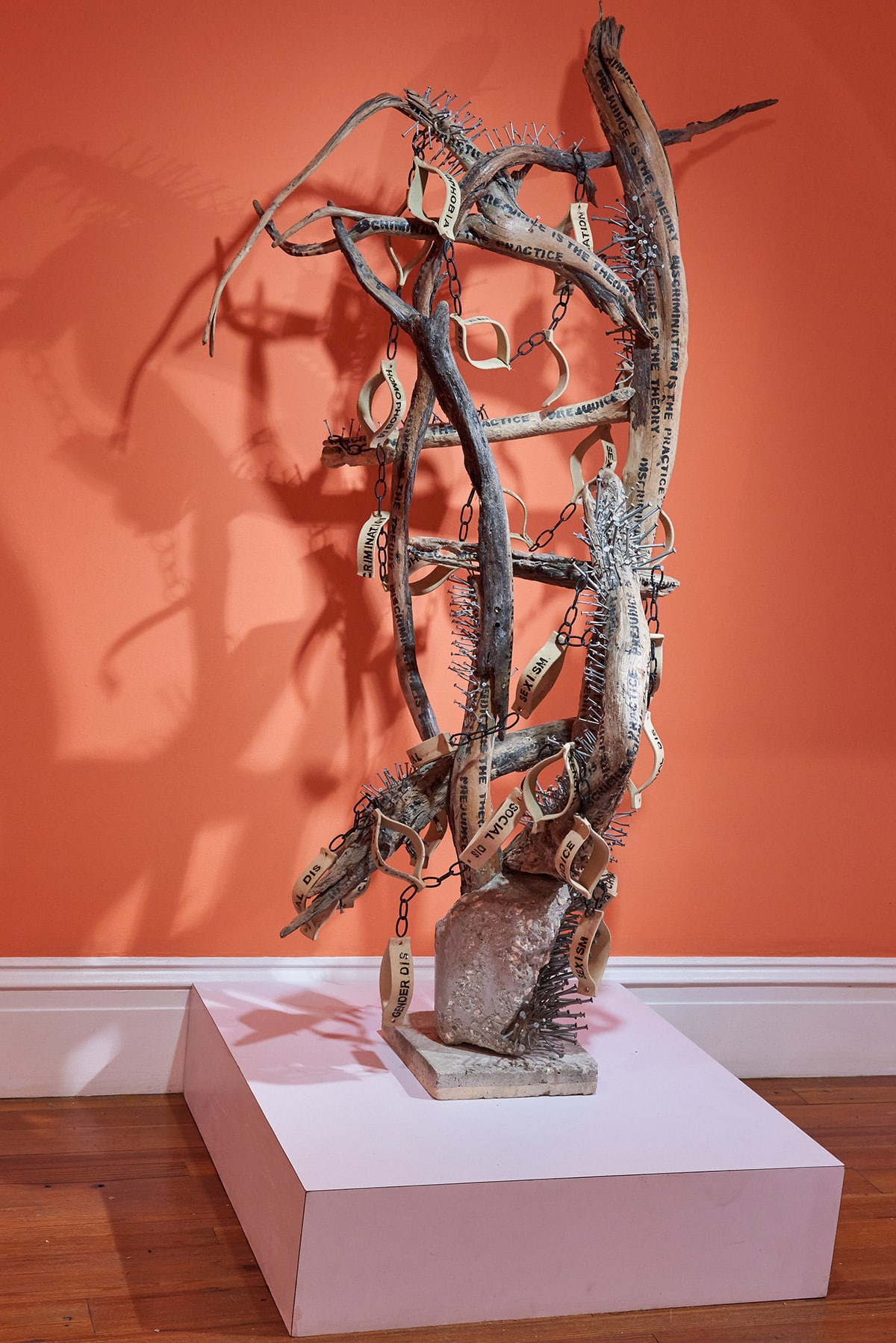To Heal We Must Remember: Katrina Cartwright’s power figure uproots the past

By Letitia Pratt
It is a hopeful mission of the African diasporas to heal the ancestral pain that Black peoples have inherited. This healing will only come to us in the process of remembering. One of the primary ways to initiate this process is through the creation and consumption of art, which invites us to remember the past, take stock of the present, and come to terms with the complex histories that influence our current experiences as Black people. This process is especially needed for Black Bahamians, whose past traumas shape how we view ourselves. It is incumbent on our ability to tell truths about our past: we must recall times of slave rebellions, punishments, uprisings and revolts. We must remember the slaves that escaped the tyranny of Lord Rolle of Exuma – only to be recaptured and severely punished – and remember the tragedy of Poor Kate of Crooked Island who died from torture in the stocks for seventeen days. (The Morning Chronicle, 1929).

Nkisi/Nkondi Figure: Prejudice is the Theory, Discrimination is the Practice (2012), Katrina Cartwright, ceramics and mixed media, 5’8 x 4’. Part of the National Collection. Images by Dante Carrer.
It is these stories we need to remember. These are the stories that shaped our ancestors. These are the traumas we need to heal from. Katrina Cartwright’s Nkisi/Nkondi Figure: Prejudice is the Theory, Discrimination is the Practice, (2012) does just that: It forces us to remember, and it inspires us to heal.
The National Art Gallery of The Bahamas (NAGB)’s current permanent exhibition, “Hard Mouth: From the Tongue of the Ocean”, examines the way we speak about ourselves. It excavates particular lores that we canonise within Bahamian culture – the gaulin wife, the Burma Road Riots– in order to learn how our cultural identities were shaped by history. Each section – of which there are four – is dedicated to highlighting different ways we tell our stories: from Amos Ferguson’s hallway dissecting language and the dialect of faith and being, to the “women’s room” that is shrouded in the conversations we have regarding social mores that affect the autonomy of women. It is within these conversations that a syncretic lore emerges: rumours turn stories, stories turn myth, and myth begetting tradition.
“Hard Mouth: From the Tongue of the Ocean” curated by Natalie Willis and Richardo Barrett expertly explores the lore that Bahamian people recite that shapes our view on our history and our present moment. For generations, these stories have crawled through our ears and point to the root of our belief systems. Just as powerful, though, are the things in our history that we refuse to acknowledge, and the exhibition also considers how we dismiss parts of the stories that we tell. These omissions can be harmful and at times lead us to repeat mistakes made in the past, stunting our ability to heal. By placing Cartwright’s Nkisi/Nkondi Figure at the end of an exhibition that uproots stories of our history, “Hard Mouth” begs us to remember the things we have silenced.
Ultimately, Cartwright’s sculpture is piece of remembering. It is a reference to the power figures that the Kongo peoples often created: highly religious objects meant to harness a great spiritual force. A Nkisi can be represented by shells, bundles of sticks, or like in Cartwright’s work, wooden figures, in which a spiritual healer (Nganga) can release these forces into the physical world. A Nkisi Nkondi figure is a little more specific; they are believed to have the power to uncover sources of affliction, to heal, and to punish. Cartwright’s Nkisi Nkondi aims to uncover the pain that our ancestors have endured; it’s subtext: “Prejudice is the Theory, Discrimination is the Practice” reminds us of the forms of racism/classism and the vestiges of slavery are the source of our pain, and theoretically calls upon the spirit within the Nkisi to come forth to help us mend.

Installation shot of Nkisi/Nkondi Figure: Prejudice is the Theory, Discrimination is the Practice (2012) on view in “Hard Mouth: From the Tongue of the Ocean” the new Permanent Exhibition on view at the NAGB through June 2019.
A Nkisi Nkondi is most recognizable through the accumulation of nails or other sharp objects inserted onto its surface. Each insertion is meant to enforce an oath between the Nganga and the spiritual force and activates either a mission of destruction or divine protection. The deeper the insertion into the Nkisi the deeper the severity of the crime committed.
In Cartwright’s sculpture, only nails are driven into the figure, which indicates offenses that are very painful and serious, again recalling an injustice. The collective trauma of racism has permeated our society in the most volatile of ways, and its permanence can still be seen within the Black experience. This pain has inspired the creation of many global activist juggernauts including the Black Lives Matter and #meToo Movements all growing out of telling the truth about our experiences. Within the Bahamian context, the 1942 Burma Road Riots stemmed from the Black majority speaking out about the oppressive economic and political conditions within Bahamian society. With this piece, Cartwright argues that both the belief in race superiority (prejudice is the theory) and the atrocities committed against the African diaspora (discrimination is the practice) is the main source of affliction that affects our global societies, and urges us to open our mouths to tell the stories about the harmful effects it has on our experiences. The power of a Nkisi Nkondi figure is only activated through the belief in its protection. We must trust our ancestral spirits to provide tools that we need heal ourselves. For generations, we have trusted the knowledge passed down from our ancestors when it comes to natural physical healing like bush medicine and ancient healing remedies which are a deep part of Bahamian culture. Now we must trust this ancestral knowledge to heal our spiritual past and begin to tell of afflictions that plague us and speak truthfully of the things our ancestors have endured.
Hard Mouth: From the Tongue of the Ocean is an exhibition that is essential to our growth as a nation. It argues that we must take time to analyse the way we have created the history and myths of our people. The accurate portrayal of our collective pain is paramount in creating honest, healthy relationships with ourselves and each other. To do this we must remember our riots, the torture due to our insurrection, and rebellions, so that when we hammer a nail into our power figure, we gain access to the power to heal.